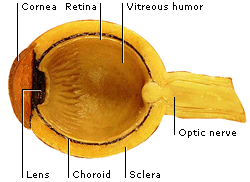DK Human Body: Eye
Our eyes create our sense of vision. They take in light rays, focus them to create an image, and convert this image into a stream of billions of nerve impulses that travels to the brain. The impulses are interpreted in different parts of the brain, but come together to create the detailed, color, 3-D image we “see.”

There are two cavities in the eye. The smaller cavity in front of the lens contains a watery substance, called aqueous humor. The larger cavity behind the lens contains a jellylike substance, called vitreous humor. This fluid fills the eye and creates the pressure that maintains the eye’s shape. Blood vessels nourish the cells of the retina.
The pupil is a hole that lets light enter the eye. It appears black, because light passes straight through it without being reflected. Around the pupil is the iris, a circle of colored muscle that controls the pupil’s size. In dim light the pupil widens to take in extra light. In bright light it shrinks to protect the nerve cells at the back of the eye.
The eye has a curved, transparent lens that bends light rays to create an image. The eye focuses images on the retina, just as a projector focuses images on a screen. To keep the image sharp, the lens changes shape. Muscles around the lens make it fatter for nearby objects and thinner for distant objects.
Each eye sees the world from a different angle, creating slightly different pictures. The brain combines these two pictures into a single, three-dimensional image. This is called binocular vision. Seeing in 3-D helps you to judge the distance and size of objects much more easily.
The cells in the retina that are sensitive to light are called rods and cones. Rods work best in dim light, but cannot see color. Cones can detect colors in bright light. There are three types of cones, and each type is sensitive to one of the primary light colors—red, blue, or green. By combining information from all three, we are able to see all the colors of the rainbow.
